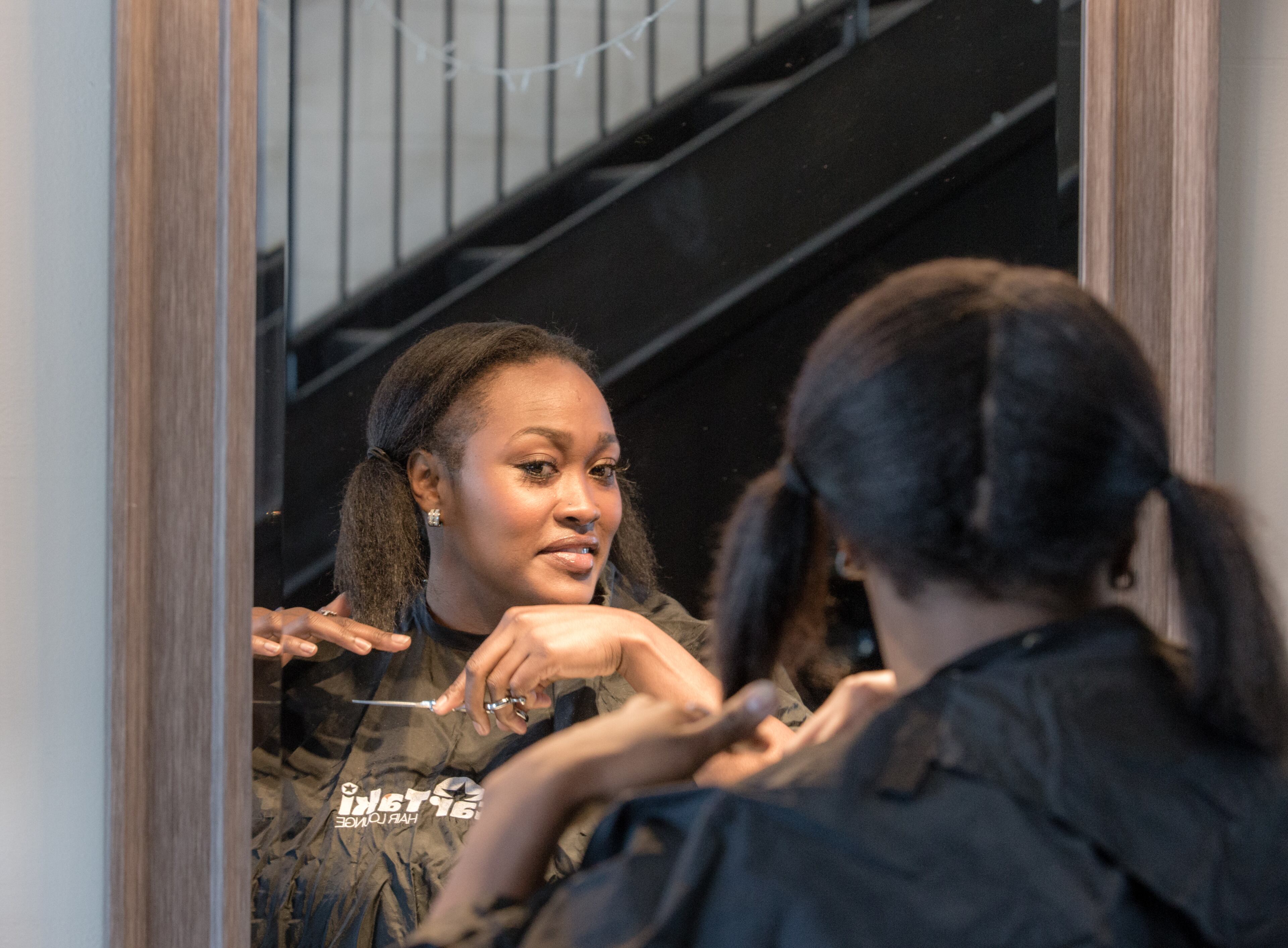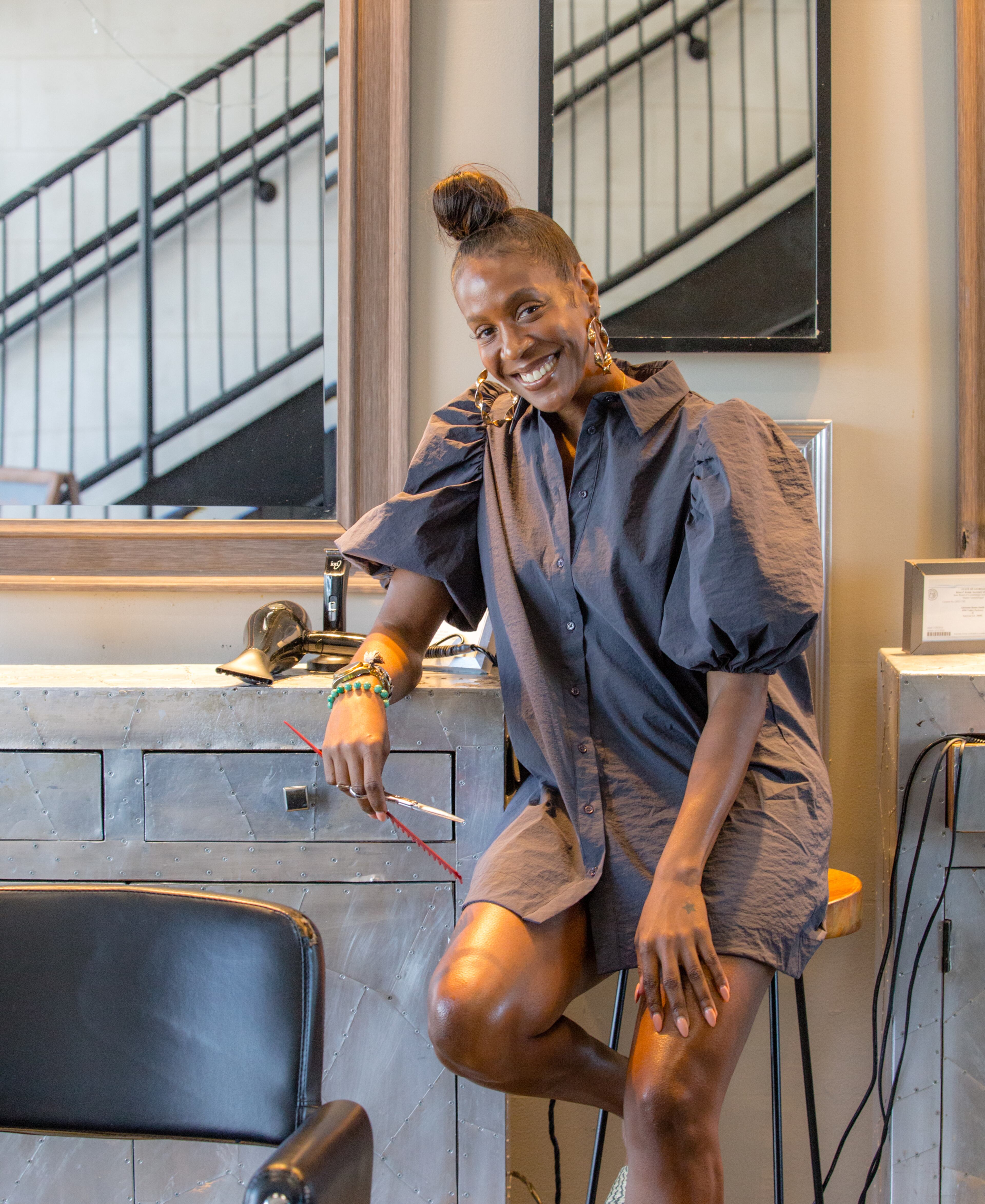How to cut your own hair

When it comes to the current social distancing precautions, there’s no clear end in sight. Georgia’s governor, Brian Kemp, has stated salons will be allowed to reopen April 24, but some people still might feel uneasy having their hair styled and cut at a salon. Quarantine has left many of us looking like quite the sight to see. If overgrown, damaged hair has you looking a little straggly, you’re not alone. With daily video conference calls and each pass by a mirror, a home haircut seems more and more attractive. Even a few social influencers and celebrities (from Hilary Duff and Pink to Susan Lucci) have hopped on the self-chopped train. Though they may have made it look fun, cute and easy, is a DIY trim really as cut and dry as it seems?
“My initial thoughts would be to not cut your hair at all,” warns professional hairstylist and lifestyle influencer Nataki Minix, who owns Star Taki Hair Lounge in Sandy Springs. “It could be a total disaster. If you are doing a bang, you can cut a bang too short or cut one side shorter than the other. If you don’t usually cut your own hair, it’s best to wait it out.”

Instead, Minix suggests utilizing the quarantine period to experiment with nourishing treatments, testing our new products or kitchen-made hair moisturizers. Basic haircare coupled with protective styles and decorative scarves may be enough to upkeep hair until you have the chance to see your normal stylist, Minix adds. Laura Silverstein, master cosmetologist and co-owner of LM Studio in Alpharetta, is in agreement, further suggesting people should take this period to avoid putting heat in their hair as well.
“Take this time to give your locks a rest, put down the blow dryer, curling iron and straightener and allow your hair a refresh. Use lots of at-home moisturizing masks,” Silverstein says. “For long hair, you can sleep in two braids to keep hair from tangling at night. Also, a silk pillowcase is great to sleep on to protect your hair while you snooze. For shorter pixie cuts, I would try playing around with cute headbands for that in-style look during an important Zoom business meeting.”

To maintain healthy hair, Silverstein recommends a trim every 10 to 12 weeks for long, straight hair and four to six weeks for shorter hair. But since shelter-at-home orders are more prominent than ever, you could well be at your wit’s end with split ends.
“But I get it,” Minix admits. “We don’t know how long we have in this thing. You are going to have to look at yourself in the mirror, so you have to do what gives you peace.”
If you’ve come to the careful decision to cut your own hair, these five metro Atlanta experts want you to be prepared. So, follow their tips for a no-regrets, at-home haircut.
Stop before you chop, and read this first
Don't cut off more than a half an inch to one inch. "Stick with a trim," Minix says. "Don't go cut it into a bob, no super short layers, no defined cut style. Leave that to a professional. A simple trim is the best."
Don't use just any pair of household scissors. "Kitchen scissors aren't thin enough and might not be sharp enough to properly cut your hair; they will bend and irritate the cuticle, and do more damage than good," says Megan Pigott, who co-owns LM Studio in Alpharetta with Silverstein. "Your hairstylist may have to charge more to correct your hair if you really butcher it." The stylists agree that it's well worth the investment to purchase a pair of hair-cutting shears (or clippers for male grooming) from the Internet or a drug store.
Don't do anything you'll have the potential to regret, such as a heat-of-the-moment mane mutilation or an overly ambitious styling attempt. "Don't cut your bangs at 2 a.m. with a glass of Chardonnay in your hand," Silverstein jokes. "I have heard the ending to that story too many times."
Don't be fooled into thinking a simple cut will be the "end" of your hair woes. You'll need some basic haircare to get you through sheltering in place. "I would still shampoo and hydrate my hair often," says Sabrina Edwards, an Atlanta-based independent stylist. "Use good products. You want to use products with nutrients and hydration to maintain healthy hair; some products on the market have too much water and alcohol."

Tips for kinky, coily and curly hair
Shampoo and condition your hair. Comb through a leave-in conditioner, and let your hair air dry naturally. “You will be able to see exactly where the hair damage is when your hair is dried naturally,” says Minix.
“Don’t just pick up hair and start to cut,” adds Edwards. “Make sure it’s sectioned off down the middle for a more even cut.”
For longer hair, Minix suggests placing hair in one ponytail and trimming a little from the ends—no more than an inch. For shorter hair, Minix recommends, parting hair evenly down the middle and placing hair in two equal ponytails, so you will be able to see both sides, then trim from the ends.
Lastly, be sure to cut straight across. “Leave the angled cut to the professionals,” Minix says. “You could end up cutting more and more while trying to correct.”

Tips for straight and wavy hair
Shampoo and condition your hair. Silverstein says trimming wet versus dry really depends on your hair type, but for a general recommendation, she suggests cutting your hair in its dry state.
“Twirl the hair tightly, and cut any ends that are frayed and sticking out, this can help clean up any split ends,” she says. “If you are trimming bangs that lay out in front, hold between your pointer and middle fingers with very light tension, and cut little by little to get the preferred length. Don’t pull down with high tension and then cut because the hair will bounce back up and be a lot shorter than you expected. If you are cutting side bangs, comb them over to the opposite side of where you usually wear them, and again, trim little by little until you reach the preferred length.”
“Less is more if you can’t control yourself,” Pigott adds.
Men’s grooming tips for straight and wavy hair textures
If you have a friend, partner or family member in your house, it’s best to recruit an assistant to help trim your nape. If you’re alone, use the hand mirror-to-bathroom mirror reflection technique to help you target the back of the neck.
“Guys, just cut your sideburns, neckline and over the ears, if you’re feeling brave. If you’re feeling really crazy and end up clippering your hair, leave the top alone,” Pigott instructs. “Only clipper the sides.”
“If the top length of your cut is super long, try holding it in clean horizontal sections and trim just the top,” Silverstein offers as an option for men who may find their newfound hair length unbearable. For men more willing to allow their locks to go the distance, she adds. “Style to the side, using gel until you can get that professional trim. Maybe bring back the man bun ‘q-style’ (quarantine style).”
Men’s grooming tips for kinky, coily, and curly hair
Start with clean hair and facial hair. “When attempting a home cut, one of the biggest mistakes is being overly aggressive,” says Aaron Tracey, a master stylist at Star Taki Hair Lounge in Sandy Springs. “Don’t push back your hairline when detailing with the trimmers. A best practice is to lightly tap the perimeter of the hairline starting from the middle of the forehead and working to your right. Repeat the same technique on the opposite side to ensure symmetry.”
Tracey, also warns, to keep things simple; do not attempt to do a fade or complicated shave style. “If you have a low cut, keep it one length by using the appropriate clipper guard,” he says, adding, “Rocking a bald head is always the easiest.”

HOW TO GROOM YOUR PUP
As stay-at-home orders stretch into another month, your family pet may also be looking a little shaggier than usual. And that’s OK, says Erica Goetz, owner of The Barking Boston Pet Spa in Milton.
“As long as you keep your pet brushed out every day and tangle-free, your groomer will be able to style your pet any way you’d like when you’re able to return to the pet salon,” she says. “I’m sure [your pets] don’t mind; they are simply happy to have their humans home all day.”
But, again, if you do decide to trim your pet, Goetz issues a few tips, tricks and warnings. First, she says to fully brush hair out before bathing your pet—and use your fingers to help work tough tangles. If your pet has matted hair, water could only worsen those twists and knots. Goetz also suggests securing your pooch with a leash before grooming, considering for safety and stability. After that, you can begin cutting.
“Scissors can be dangerous especially when there are mats [of hair] involved. It can be hard to tell where a mat ends and the pet’s skin begins,” she says, recommending clippers as the safer option instead. “When grooming a pet with clippers, follow the natural growth pattern of the hair as you clip.”
Lastly, don’t forget the love.
“Do not get frustrated if your pet doesn’t respond well to at-home grooming. This is totally normal. And sometimes simply taking breaks for kisses and snacks is all it takes,” she says. “Pets respond well to positive feedback, and it will make it a bonding experience for both of you.”
—Nina Hemphill Reeder

